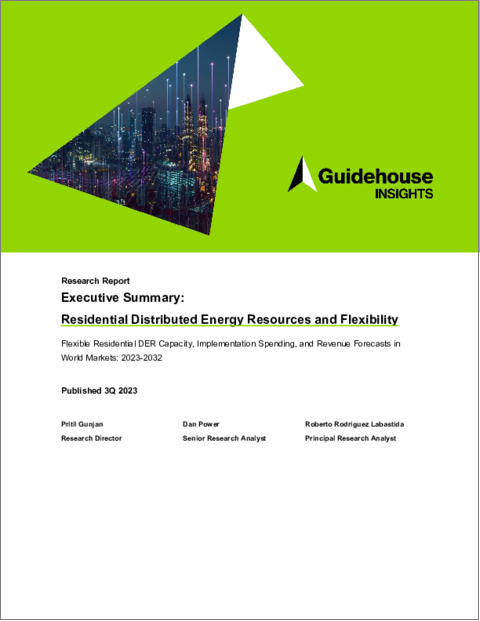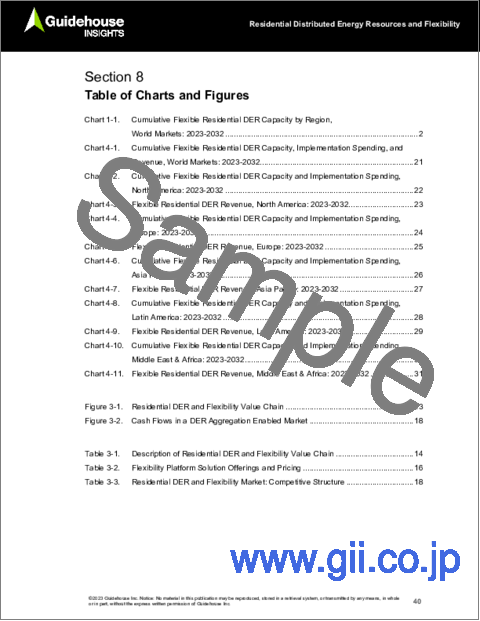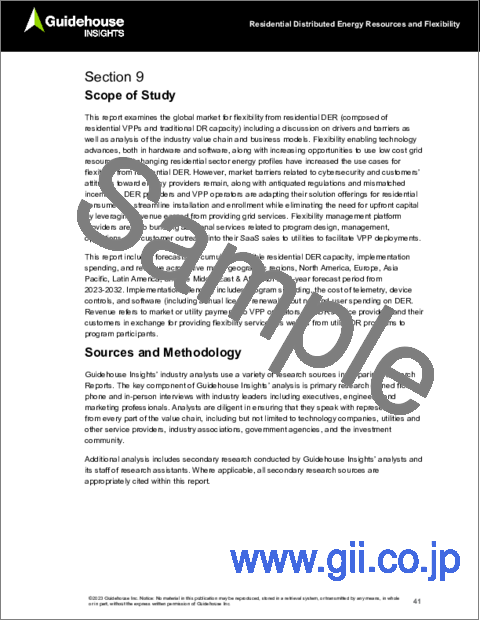|
|
市場調査レポート
商品コード
1345883
住宅用DER (分散型エネルギー資源) とフレキシビリティ:世界市場におけるフレキシブル住宅用DERの発電能力、導入支出、収益予測 (2023年~2032年)Residential Distributed Energy Resources and Flexibility: Flexible Residential DER Capacity, Implementation Spending, and Revenue Forecasts in World Markets, 2023-2032 |
||||||
|
|||||||
| 住宅用DER (分散型エネルギー資源) とフレキシビリティ:世界市場におけるフレキシブル住宅用DERの発電能力、導入支出、収益予測 (2023年~2032年) |
|
出版日: 2023年09月01日
発行: Guidehouse Research
ページ情報: 英文 44 Pages; 47 Tables, Charts & Figures
納期: 即納可能
|
- 全表示
- 概要
- 図表
- 目次
送電網におけるフレキシビリティのニーズは、従来、制御可能な化石燃料発電所によって対処されてきました。しかし、世界各国がより多くの再生可能エネルギー容量を導入することで排出量を削減しようとしているため、フレキシビリティのニーズを満たすために新しい手法を使用する必要があります。住宅用DER (分散型エネルギー資源) の件数は世界のどの地域でも増加する一方、先進的なソフトウェア・プラットフォームの開発により、仮想発電所 (VPP) といった従来型の需要応答 (DR) を超えた、一体型の住宅用DERの新たな使用事例が可能になりました。
当レポートでは、従来のDRに加え、小売用・卸売用VPPを含むフレキシブルな住宅用DER市場について分析し、主要5地域の発電能力・導入支出・収益の見通し (2023年~2032年) や、技術の種類別の発電能力を予測しています。フレキシブルな住宅用DERの全体的な発電能力は、予測期間の大半を通じて北米が最大となる見込みですが、2032年には欧州が最大になると考えられています。その理由として、プロジェクトの初期費用を抑えるために、必要に応じて設備を追加投入する傾向が挙げられます。
当レポートではまた、主要13社のDAC製品を調査し、最も有用なDACソリューションを提供している企業を決定するため、各社を比較評価しています。
上位ベンダー10社
Climeworks
Carbon Engineering
Global Thermostat
Baker Hughes/Mosaic
CarbonCapture
Aircapture
Carbyon
Noya
Prometheus Fuels
Mission Zero
目次
第1章 エグゼクティブサマリー
第2章 市場の問題
- イントロダクション
- 促進要因
- 技術進歩を可能にするフレキシビリティ
- 低コストの系統リソースの機会
- 新しい住宅部門のエネルギープロファイル
- 阻害要因
- サイバーセキュリティ・顧客プライバシー・ユーティリティに対する顧客の認識
- 時代遅れの規制と不一致のインセンティブ
- その他のビジネス上の問題
- 初期費用
- フレキシビリティのインセンティブと収益源
- 顧客への働きかけと教育
- 住宅用DERの技術力
第3章 業界のバリューチェーン
- イントロダクション
- バリューチェーンの図解
- 競合情勢
- 企業合併・買収 (M&A)
- 価格設定
- ビジネスモデルの進化
第4章 市場予測
- 予測の概要
- 前提条件と調査手法
- 世界の住宅用DERフレキシビリティ市場
- 地域別の情勢予測
- 北米
- 欧州
- アジア太平洋
- ラテンアメリカ
- 中東・アフリカ
第5章 結論・提言
- 結論
- 3つの大きなポイント
- 推奨事項
- DER技術ベンダー
- ユーティリティ
- 規制当局と市場オペレーター
第6章 頭字語・略語一覧
第7章 目次
第8章 図表
第9章 分析範囲
第10章 出典・分析手法・注記
List of Tables
- Flexible Residential DER Capacity by Region, World Markets: 2023-2032
- Flexible Residential DER Revenue by Region, World Markets: 2023-2032
- Flexible Residential DER Implementation Spending by Region, World Markets: 2023-2032
- Cumulative Flexible Residential DER Capacity, North America: 2023-2032
- Flexible Residential DER Revenue, North America: 2023-2032
- Flexible Residential DER Implementation Spending, North America: 2023-2032
- Cumulative Flexible Residential DER Capacity, Europe: 2023-2032
- Flexible Residential DER Revenue, Europe: 2023-2032
- Flexible Residential DER Implementation Spending, Europe: 2023-2032
- Cumulative Flexible Residential DER Capacity, Asia Pacific: 2023-2032
- Flexible Residential DER Revenue, Asia Pacific: 2023-2032
- Flexible Residential DER Implementation Spending, Asia Pacific: 2023-2032
- Cumulative Flexible Residential DER Capacity, Latin America: 2023-2032
- Flexible Residential DER Revenue, Latin America: 2023-2032
- Flexible Residential DER Implementation Spending, Latin America: 2023-2032
- Cumulative Flexible Residential DER Capacity, Middle East & Africa: 2023-2032
- Flexible Residential DER Revenue, Middle East and Africa: 2023-2032
- Flexible Residential DER Implementation Spending, Middle East & Africa: 2023-2032
Description of Residential DER and Flexibility Value Chain
Flexibility Platform Solution Offerings and Pricing
Residential DER and Flexibility Market: Competitive Structure
List of Figures
- Cumulative Flexible Residential DER Capacity by Region, World Markets: 2023-2032
- Cumulative Flexible Residential DER Capacity, Implementation Spending, and Revenue, World Markets: 2023-2032
- Cumulative Flexible Residential DER Capacity and Implementation Spending, North America: 2023-2032
- Flexible Residential DER Revenue, North America: 2023-2032
- Cumulative Flexible Residential DER Capacity and Implementation Spending, Europe: 2023-2032
- Flexible Residential DER Revenue, Europe: 2023-2032
- Cumulative Flexible Residential DER Capacity and Implementation Spending, Asia Pacific: 2023-2032
- Flexible Residential DER Revenue, Asia Pacific: 2023-2032
- Cumulative Flexible Residential DER Capacity and Implementation Spending, Latin America: 2023-2032
- Flexible Residential DER Revenue, Latin America: 2023-2032
- Cumulative Flexible Residential DER Capacity and Implementation Spending, Middle East & Africa: 2023-2032
- Flexible Residential DER Revenue, Middle East and Africa: 2023-2032
- Cumulative Flexible Residential DER Capacity by Region, World Markets: 2023-2032
- Cumulative Flexible Residential DER Capacity, Implementation Spending, and Revenue, World Markets: 2023-2032
- Cumulative Flexible Residential DER Capacity and Implementation Spending, North America: 2023-2032
- Flexible Residential DER Revenue, North America: 2023-2032
- Cumulative Flexible Residential DER Capacity and Implementation Spending, Europe: 2023-2032
- Flexible Residential DER Revenue, Europe: 2023-2032
- Cumulative Flexible Residential DER Capacity and Implementation Spending, Asia Pacific: 2023-2032
- Flexible Residential DER Revenue, Asia Pacific: 2023-2032
- Cumulative Flexible Residential DER Capacity and Implementation Spending, Latin America: 2023-2032
- Flexible Residential DER Revenue, Latin America: 2023-2032
- Cumulative Flexible Residential DER Capacity and Implementation Spending, Middle East & Africa: 2023-2032
- Flexible Residential DER Revenue, Middle East & Africa: 2023-2032
Residential DER and Flexibility Value Chain
Cash Flows in a DER Aggregation Enabled Market
Flexibility needs on the power grid have traditionally been addressed by dispatchable fossil fuel power plants. However, as economies around the world look to cut emissions by installing more renewable energy capacity, new methods must be used to meet those flexibility needs. The number of residential distributed energy resources (DER) is increasing in every world region while the development of advanced software platforms has enabled new use cases for aggregated residential DER, beyond traditional demand response (DR), like virtual power plants (VPPs).
Outside of flexibility enabling technology advances, the market for flexibility from residential DER is being driven by opportunities for low cost grid resources and segment energy profile changes. Hindering further market growth are cybersecurity concerns, legacy customer attitudes towards energy providers, and antiquated energy sector regulations. Other remaining business issues include customer financial considerations for DER and limited customer education. Companies involved in residential DER and flexibility are diverse with some focusing on hardware, others on software, and several choosing to aggregate and operate VPPs. Technology vendors in the market are adapting their solution offerings to facilitate further market growth.
This Guidehouse Insights report examines the flexible residential DER market including retail and wholesale VPPs along with traditional DR. Regional level forecasts for capacity, implementation spending, and revenue are presented across five major geographic regions from 2023-2032 with capacity forecasts segmented by technology type. Total flexible residential DER capacity is projected to be largest in North American throughout most of the forecast period with Europe showing the largest total capacity by 2032. to deploy additional units as necessary in order to minimize initial upfront costs for a project.
This Guidehouse Insights Leaderboard examines the DAC offerings from 13 leading companies and measures them against one another to determine which are providing the most useful DAC solutions.
Top 10 Vendors
1. Climeworks
2. Carbon Engineering
3. Global Thermostat
4. Baker Hughes/Mosaic
5. CarbonCapture
6. Aircapture
7. Carbyon
8. Noya
9. Prometheus Fuels
10. Mission Zero
Table of Contents
1. Executive Summary
- 1.1 Introduction
- 1.2 Market Issues
- 1.3 Industry Value Chain
- 1.4 Market Forecasts
2. Market Issues
- 2.1 Introduction
- 2.2 Drivers
- 2.2.1 Flexibility Enabling Technology Advances
- 2.2.1.1 Case Study: Sense and OhmConnect
- 2.2.2 Low Cost Grid Resource Opportunities
- 2.2.2.1 Case Study: Green Mountain Power and Virtual Peaker
- 2.2.3 New Residential Sector Energy Profiles
- 2.2.1 Flexibility Enabling Technology Advances
- 2.3 Barriers
- 2.3.1 Cybersecurity, Customer Privacy, and Customer Perception of Utilities
- 2.3.2 Antiquated Regulations and Mismatched Incentives
- 2.4 Other Business Issues
- 2.4.1 Upfront Costs
- 2.4.2 Flexibility Incentives and Revenue Streams
- 2.4.3 Customer Outreach and Education
- 2.4.4 Technical Ability of Residential DER
3. Industry Value Chain
- 3.1 Introduction
- 3.2 Pictorial Representation of the Value Chain
- 3.3 Competitive Landscape
- 3.3.1 Mergers and Acquisitions
- 3.3.2 Pricing
- 3.3.3 Business Model Evolution
4. Market Forecasts
- 4.1 Forecast Introduction
- 4.2 Assumptions and Methodology
- 4.3 Global Residential DER Flexibility Market
- 4.4 Regional Forecasts
- 4.4.1 North America
- 4.4.2 Europe
- 4.4.3 Asia Pacific
- 4.4.4 Latin America
- 4.4.5 Middle East & Africa
5. Conclusions and Recommendations
- 5.1 Conclusions
- 5.2 Three Big Takeaways
- 5.3 Recommendations
- 5.3.1 DER Technology Vendors
- 5.3.2 Utilities
- 5.3.3 Regulators and Market Operators






